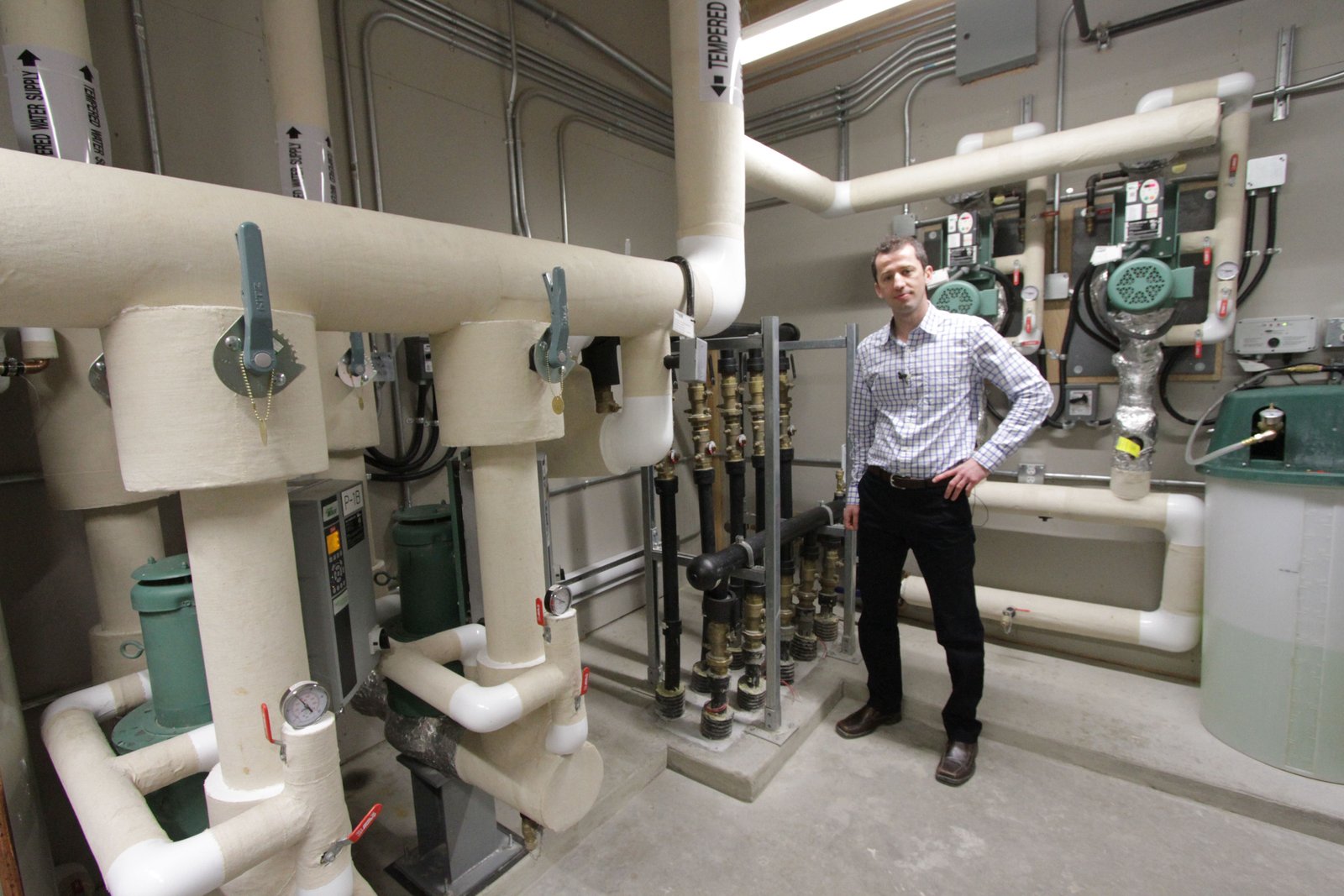By David Dodge and Duncan Kinney

The Mosaic Centre is Canada’s largest commercial net-zero building. It’s located in south Edmonton and has a geothermal system combined with 213 kilowatts of solar PV. Photo by David Dodge, Green Energy Futures.
There is something calm and comforting about getting energy from the warmth of the earth. Perhaps this explains why so many people are curious about geothermal energy and why our second most popular Green Energy Futures video is called Geothermal 101.
Geothermal, also called geoexchange, has one big weakness — high upfront cost. And while our first episode concentrated on residential systems, this time we’ve found a more appropriate sweet spot for these systems — commercial buildings. We also found an incredible example of this sweet spot in the Mosaic Centre in Edmonton, one of the largest net-zero commercial buildings in Canada.
How we harvest heat from the earth
Jacob Komar was the mechanical engineer for the Mosaic project and designed the Mosaic Centre’s geoexchange system. Komar calls geothermal a renewable mechanical system that takes advantage of the stable 4-6 degree C temperature of the earth below the frost line.
You tap into that stable temperature by installing pipes in the ground connected to a heat pump. This ground source heat pump uses electricity to extract the heat from the ground when heating is needed, or sending the heat from the house into the ground when cooling is needed.
“It’s sort of like the way your fridge works in that it cools the stuff inside your fridge by heating up your home,” says Komar.
Commercial net-zero buildings and geothermal

Jacob Komar of Revolve Engineering designed the geoexchange heating and cooling system in the new net-zero Mosaic Centre in Edmonton, Alberta. Photo David Dodge, Green Energy Future
Park your car at the Mosaic Centre and you’ll be blissfully unaware of the two kilometres of pipe in 32 boreholes that go 70 metres deep under the parking lot on the north side of the building.
“Instead of 80 or 90 per cent efficiency, our heating efficiencies can get up to 400-450 per cent, and our cooling efficiencies can be anywhere from 600-900 per cent. So we typically use 70 per cent less energy than any other traditional system,” says Komar.
Komar says the real sweet spot for geothermal systems is larger commercial buildings that have a demand for cooling. Aside from geothermal systems being energy efficient, they also replace both the heating and the air conditioning systems.
“On larger commercial buildings where you’re compared to more complicated mechanical systems, the savings can be more than worth it. We’ve seen paybacks of two years, three years, on buildings as small as 60,000 square feet,” says Komar.
Geothermal systems aren’t perfect for every situation. They are relatively expensive and they don’t make a ton of sense for smaller buildings or buildings without significant cooling loads, at least for now.
But the Mosaic Centre, like a lot of the net-zero houses we’ve featured, has a tight building envelope, a preponderance of south-facing glass and thermally massive concrete floors. And with that energy efficient design comes a need to be cooled on sunny days, even in the winter. When we were there in early April it was around zero degrees Celsius and the cooling system was working away.
Combining geothermal and solar just makes sense

The Mosaic Centre is powered by 213 kilowatts of solar and heated and cooled by a geoexchange system that draws heat from the earth in winter to heat the building and deposits heat in the earth in summer to cool the building. Photo David Dodge, Green Energy Futures
Pairing geothermal with solar PV is as good a match as peanut butter and jelly. Geothermal moves your heating and cooling to an electric source, and is far more efficient than the baseboard heaters we typically find in net-zero houses. And solar PV is as cheap as ever and produces electricity to offset the electricity use.
And what they discovered when they were designing the Mosaic Centre was that by going with an efficient, all-electric mechanical system, they needed fewer solar PV modules to get to net-zero. Geothermal systems are also simpler than your standard mechanical system and as a result there is a lot less machinery and infrastructure on the roof. That means more space for solar PV modules.
Another big difference between the home and commercial applications is Canada’s “Accelerated Capital Cost Allowance for Efficient and Renewable Energy Generation Equipment.” It’s an accounting trick that allows you to write off the capital cost of the equipment faster than you would otherwise be able to. And it softens the economic blow for systems like geothermal and solar that have high upfront costs but lower operations and maintenance costs over time
Geothermal’s future
Heating and cooling consume vast amounts of energy and produce plenty of greenhouse gas emissions. Geothermal is a more efficient option. While it isn’t the right fit for every application, it is an up and coming efficient, effective technology for commercial scale buildings.
The marriage of geothermal and solar now makes a future with net-zero commercial buildings a realistic choice. And according to the Canadian GeoExchange Coalition, more than 100,000 geoexchange systems have been installed in Canada.
“The potential is absolutely huge. I think for commercial buildings, the paybacks and the attractiveness is already there,” says Komar.
“For residential buildings, until natural gas prices bounce back, it’s going be a tougher sell. My guess is in five, 10, 15 years, when we’re going to want to use a lot less fossil fuels, there’s not a single building that won’t at least consider geothermal.”


